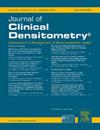在血红蛋白病患者中,骨质量与脆性骨折有关
IF 1.6
4区 医学
Q4 ENDOCRINOLOGY & METABOLISM
引用次数: 0
摘要
背景:低骨量,定义为骨矿物质密度(BMD) z评分≤-2.0,在地中海贫血(Thal)和镰状细胞病(SCD)的成人中很常见,尽管疾病特异性的人为因素可能导致BMD评估的不准确性。骨质量指标小梁骨评分(TBS)不容易受到这些挑战的影响,可以改善骨折风险预测。方法:对过去10年中至少进行过一次DXA脊柱骨密度扫描的Thal或SCD患者进行回顾性图表回顾。重新分析最近一次扫描的骨质量,异常定义为TBS <;1.2。骨折发生率由患者报告和医疗记录验证确定。将患者与之前参与研究的健康对照组进行比较。结果:数据抽象从126年患者需要(31.7 ± 11.9岁,男性51 %),170年SCD(24.6 ± 13.5年,43 %男性),和64名对照(25.9 ± 8.0岁,17 %男性)。与对照组(0 %,p <; 0.001)相比,TBS异常在Thal(26 %)或SCD(7 %)中更为常见。与SCD组(23 %)和对照组(16 %,p = 0.005)相比,Thal组(36 %)的骨折发生率更高。在对照组中未观察到脆性骨折,但占Thal骨折的21. %和SCD骨折的15. %。在调整年龄和性腺功能减退后,低骨量与骨折发生率增加相关(OR: 1.8, 95 % CI: 1.03, 3.23;P = 0.041),但与脆性骨折无关。相反,调整年龄、性别和BMI后,TBS异常与脆性骨折密切相关(OR: 11.4, 95 % CI: 2.2, 59.1, p = 0.004)。结论:TBS的骨质量可能是预测患有血红蛋白病的年轻成人脆性骨折风险的一个有价值的工具,在决定对那些刚发生骨折的低骨密度患者进行抗再吸收治疗时,或者在单纯通过骨密度进行准确的脊柱评估时,应考虑到TBS的骨质量。本文章由计算机程序翻译,如有差异,请以英文原文为准。
Bone quality is associated with fragility fracture in patients with hemoglobinopathies
Background: Low bone mass, defined as a bone mineral density (BMD) Z-score ≤-2.0, is common in adults with thalassemia (Thal) and sickle cell disease (SCD), though disease-specific artifacts may contribute to inaccuracies in BMD assessment. Trabecular bone score (TBS), an indicator of bone quality, is not susceptible to these challenges and may improve fracture risk prediction.
Methods: A retrospective chart review was conducted in patients with Thal or SCD who had at least one spine BMD scan by DXA in the past 10 years. The most recent scan was reanalyzed for bone quality with abnormal defined as TBS <1.2. Fracture prevalence was determined by patient report with medical record validation. Patients were compared to healthy controls who participated in previous research.
Results: Data were abstracted from 126 patients with Thal (31.7 ± 11.9 yrs, 51 % Male), 170 with SCD (24.6 ± 13.5 yrs, 43 % Male), and 64 controls (25.9 ± 8.0 yrs, 17 % Male). Abnormal TBS was more common in Thal (26 %) or SCD (7 %) compared to controls (0 %, p < 0.001). Fracture prevalence was greater in Thal (36 %) compared to SCD (23 %) and controls (16 %, p = 0.005). Fragility fractures were not observed in controls but constituted 21 % of fractures in Thal and 15 % in SCD. After adjusting for age and hypogonadism, low bone mass was associated with an increased fracture prevalence (OR: 1.8, 95 % CI: 1.03, 3.23; p = 0.041), but not with fragility fracture. In contrast, abnormal TBS was strongly associated with fragility fracture after adjustment for age, sex, and BMI (OR: 11.4, 95 % CI: 2.2, 59.1, p = 0.004).
Conclusions: Bone quality by TBS may be a valuable tool in predicting the risk of fragility fractures in young adults with hemoglobinopathies and should be considered when making decisions for anti-resorptive therapy in those with low BMD naive to fracture or where disease-specific artifacts complicate accurate spine assessment by BMD alone.
求助全文
通过发布文献求助,成功后即可免费获取论文全文。
去求助
来源期刊

Journal of Clinical Densitometry
医学-内分泌学与代谢
CiteScore
4.90
自引率
8.00%
发文量
92
审稿时长
90 days
期刊介绍:
The Journal is committed to serving ISCD''s mission - the education of heterogenous physician specialties and technologists who are involved in the clinical assessment of skeletal health. The focus of JCD is bone mass measurement, including epidemiology of bone mass, how drugs and diseases alter bone mass, new techniques and quality assurance in bone mass imaging technologies, and bone mass health/economics.
Combining high quality research and review articles with sound, practice-oriented advice, JCD meets the diverse diagnostic and management needs of radiologists, endocrinologists, nephrologists, rheumatologists, gynecologists, family physicians, internists, and technologists whose patients require diagnostic clinical densitometry for therapeutic management.
 求助内容:
求助内容: 应助结果提醒方式:
应助结果提醒方式:


